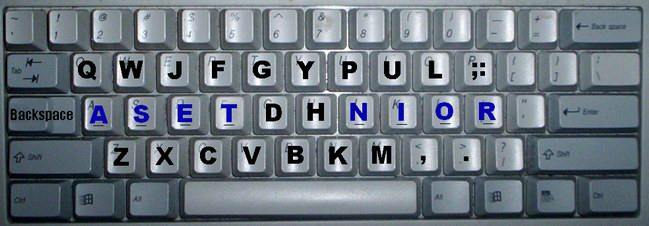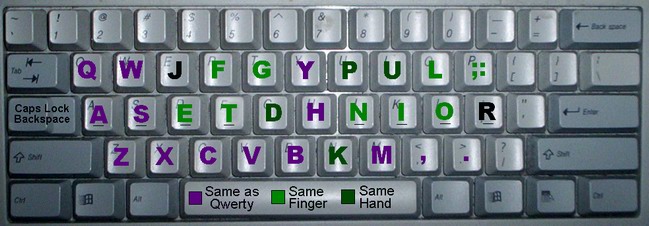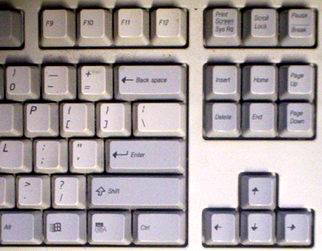

Having been fed up with Qwerty, I decided in 2004 to learn Dvorak. I was surprised how difficult it was to learn, and noticed a curious phenomenon: I would often type letters on Dvorak with the correct finger, but the wrong hand. I came to the conclusion that the hand to use was distinct in my brain from the finger. This led me to hypothesize that there were three separate things I had to learn in order to use a new layout:
| Class | Approximate prominance of each character in English documents, respectively | |
| 0. Space character | 18.7% (may be skewed upward by certain documents that have large runs of spaces) | |
| 1. Most common characters | E T | 9.6% and 7.0% (total 16.6%) |
| 2 | A O I N H S R | 6.2% to 4.4% (total 36.5%) |
| 3 | D L U | 3.5% to 2.3% (total 9.0%) |
| 4 | M C W G F Y | 1.9% to 1.6% (total 10.48%) |
| 5 | P , . B | 1.3% to 1.2% (total 5.0%) |
| 6. | K V " ' - | 0.7% to 0.3% (total 2.8%) |
| 7. Least common characters | ? X J ; ! Q Z : | 0.2% and below (total 0.7%) |
See also: Letter frequencies of French and German (based on this page)
| French | E.ASITN.RUOL.D.XCMP.VQYGFB.HZJ.KW |
| Spanish | EA.OS.RNID.LCTU.MP.BGYVQHF.ZJ.XWK |
| German | E.NIRS.ATDUH.LGOC.M.BFWK.ZVP.JYXQ |

a an are as at did do does has had he her here there in into is it its no neither nor not on or she so to too then than that their these
Thus, while initially learning this keyboard, many meaningful sentences can be constructed with only the home keys and home row. Additionally, 60 words can be formed from ASET alone and 10 from NIOR alone. Unlike with Qwerty, Asset touch typing tutors do not require users to type dull sets of nonsense words.
As I've said, the bottom row of the standard keyboard is misaligned. When your fingers are on home row and you move them down, they end up between the keys below, which makes it unnecessarily difficult to press keys on the bottom row, especially (in Qwerty) Z, X, C, comma, period and slash. I believe these keys should be moved left by about 1/4 the width of a key.
I also find that while pressing those six keys, I need to use my fingernails to apply pressure. This is especially true on my small laptop, where there is not enough room to stretch out my hands enough to avoid using my fingernails. I'm sure the ergonomics people have looked at this, but for some reason an improved shape for the keys, that will allow the base of the finger to apply the pressure, has not generally been introduced.
I hear that there were several keyboards in the 70's and 80's that had the Control and Caps Lock keys swapped from where they are now. At this point I am so accustomed to the status quo that I would resent going back. However, Caps Lock is easier to press from home row, so it is a shame it was wasted on the Caps Lock function which decent people almost never use.
 I wish the keyboard designers
would quick screwing with the extended key region. On the
right side you can see the standard extended key block.
(Insert, Delete, arrow keys, etc.) This style has been
around for at least 20 years, but for some reason many
new keyboard designs have a rearranged extended key
block. Often they also make it less ergonomic by
shrinking the keys. Look, it was fine the way it was.
Besides, if you're going to change it, get some industry
consensus first--I think I've seen three different
layouts besides the standard one. And another thing:
there have always been spaces between F4 and F5, and
between F8 and F9. Some keyboards now remove that space. Why?
It ain't broke, and that is no improvement.
I wish the keyboard designers
would quick screwing with the extended key region. On the
right side you can see the standard extended key block.
(Insert, Delete, arrow keys, etc.) This style has been
around for at least 20 years, but for some reason many
new keyboard designs have a rearranged extended key
block. Often they also make it less ergonomic by
shrinking the keys. Look, it was fine the way it was.
Besides, if you're going to change it, get some industry
consensus first--I think I've seen three different
layouts besides the standard one. And another thing:
there have always been spaces between F4 and F5, and
between F8 and F9. Some keyboards now remove that space. Why?
It ain't broke, and that is no improvement.
Hey laptop designers! Quit putting the FN key where the Control key is supposed to be! The FN key is one of the least important keys on the keyboard so it should get out of the way. Hey widescreen laptop designers! A wide laptop should have a wide keyboard! There's room for a full size extended key block in some of these gigantic machines, so go ahead and put it in. Better yet, multiplex a full size extended key block with a numeric keypad. And while you're at it, how about a subwoofer? Yeah...
It's unfortunate that the shift key is required for round brackets but not square ones. It should be the other way around. It's also unfortunate that keyboard designers can't agree on where to put the backslash.
It seems odd that / ? were put on one key instead of say, ! and ?. It also seems strange that ? requires shift while period and slash do not.
It seems odd that minus does not require Shift but plus does. I think + and = should be swapped.
The Windows key you see on new keyboards is rather presumptuous, isn't it? It presumes that everyone uses only Windows on their PC and solidifies Windows as the status quo. However, I think the key itself is a good idea. The Windows key is normally reserved for system-level commands, i.e. commands that are independent of the active program. This is useful. I would just like to see the icon changed to something generic. Also, there are so many modifier keys now (9: two Shifts, two Controls, two Alts, two Windows, and one Context Menu), that two Windows keys seems excessive.